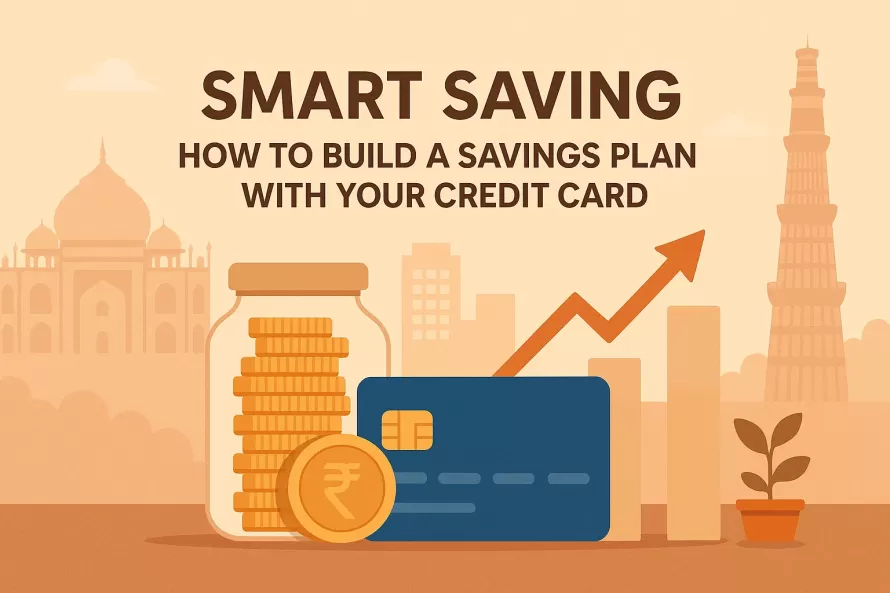How to Build a Savings Plan With Your Credit Card

When people think about credit cards, the first thing that usually comes to mind is spending. But what if you could actually use your credit card to help you save money instead? While credit cards are not savings accounts, they can still play a smart role in your financial plan—if you use them carefully. In this blog, we’ll show you how to create a savings plan using your credit card, in a way that’s simple, safe, and practical.
Start by Choosing the Right Credit Card
Before you start, make sure you’re using a credit card that matches your spending habits. For example, if you spend a lot on groceries or gas, a cashback card that gives money back on those items can be a smart pick. If you like eating out or traveling, a rewards card that earns points for flights or meals might work better. Some cards also offer 0% interest for a limited time, which can help you pay for big purchases without extra costs—as long as you pay on time.
Choose a credit card that complements your spending habits and rewards you accordingly:
- Cashback Cards: Good for everyday purchases (e.g., groceries, fuel).
- Rewards Cards: Earn points for travel, shopping, or dining.
- Zero Interest Cards: Great for managing balance transfers or large planned purchases.
Tip: Use comparison sites like RatingOK.com to find top cashback or rewards credit cards.
Set a Monthly Budget and Stick to It
To save effectively, you need to plan your spending. Create a monthly budget and divide it into categories like groceries, bills, shopping, and entertainment. You can follow a simple rule like the 50-30-20 method. That means spending 50% of your income on needs, 30% on wants, and saving 20%. This helps you stay in control and avoid using your credit card for unnecessary things.
Use Your Credit Card Only for Essential Purchases
A key part of this savings plan is using your credit card for things you already need to buy—like groceries, fuel, or phone bills. This way, you’re not increasing your spending, but you’re still earning cashback or rewards for those purchases. The most important thing is to pay off your credit card bill in full every month. That way, you avoid paying interest, and you’re really saving money.
- Use it for routine expenses you would pay anyway.
- Always pay your bill in full to avoid interest.
Save the Cashback and Rewards You Earn
Many credit cards give you cashback or points when you spend. Instead of using those rewards right away, try to save them. For example, if you earn cashback, you can move that money to your savings account each month.
If you get points, use them to buy things you normally spend money on, like gift cards or groceries. Then, put the money you would’ve spent into your savings. Over time, these small rewards can add up and help you save more.
Use Apps and Alerts to Track Your Spending
Most credit cards have a mobile app that makes it easy to see how you're spending your money. The app usually shows your recent purchases, what categories you're spending in (like food, shopping, or bills), and when your payment is due. These features help you stay on top of your spending and avoid going over your budget. You can also turn on alerts to let you know when you're getting close to your credit limit.
Watching your spending through the app helps you understand where your money goes each month. Once you see your habits clearly, it’s easier to spot areas where you might be spending too much—like eating out or shopping. By cutting back in those areas, you can save more money without feeling like you're missing out. It’s a simple way to take control of your finances and start building better saving habits.
Consider Using No-Cost EMI Options
Some credit cards offer no-cost EMI (Equated Monthly Installment) options, which let you split big purchases into smaller monthly payments without extra charges. This is only helpful if you’ve planned for the purchase and know you can afford the payments. If used wisely, this allows you to avoid big one-time expenses and keep your savings plan running smoothly.
Create a Savings Habit Linked to Your Card Use
A good way to start saving is to make a simple rule for yourself. For example, every time you earn cashback from your credit card or skip buying something you don’t really need, take that money and move it into your savings account. It doesn’t have to be a big amount—even small savings can make a difference.
Doing this regularly helps you build a habit of saving without making major changes to how you live. Over time, those small amounts add up, and you’ll start to see real progress in your savings. It’s an easy and smart way to grow your money with little effort.
Avoid Interest by Paying in Full
Never carry a balance on your credit card. If you do, the interest charges can be very high and will cancel out any cashback or rewards you’ve earned. Set up auto-pay for the full bill amount so you never miss a payment. This is one of the most important parts of using a credit card for saving.
Review Your Plan Every Month
At the end of each month, take a few minutes to review how much you spent and how much you saved using your credit card. This will help you make better decisions in the future and adjust your plan if needed. You’ll be able to see whether certain purchases are helping or hurting your savings goals.
Set Clear Goals for the Money You Save
Think about what you’re saving for. Whether it’s a trip, a new phone, or an emergency fund, having a clear goal makes it easier to stay motivated. When you see the money you saved from using your credit card wisely, it feels good—and it gives you more control over your finances.
Real-Life Example
Let’s say you spend ₹6,000 a month on groceries, ₹2,000 on fuel, and ₹3,000 on online shopping. If your credit card gives you 5% cashback on groceries and shopping, and 3% on fuel, you’d earn ₹300 from groceries, ₹150 from shopping, and ₹60 from fuel—that’s ₹510 per month. If you transfer that cashback to your savings account every month, you’ll have saved over ₹6,000 in a year—just from spending on things you already needed.
Final Thoughts
Using a credit card doesn’t have to mean going into debt. In fact, it can be a useful tool for saving if you’re smart about it. By choosing the right card, using it for everyday needs, tracking your expenses, and saving the cashback you earn, you can build a strong savings habit without changing your spending too much. It might seem like small steps at first, but over time, they lead to big results.




Leave a Reply